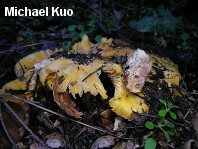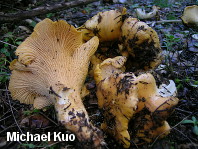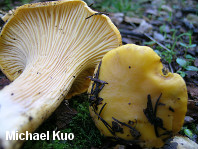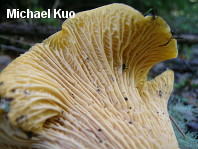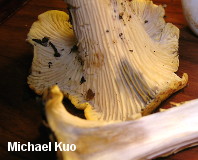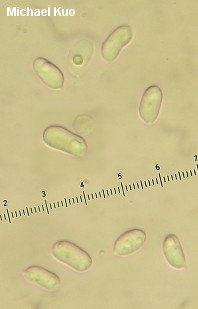| Major Groups > Chanterelles and Trumpets > Cantharellus californicus |

|
Cantharellus californicus [ Basidiomycota > Cantharellales > Cantharellaceae > Cantharellus . . . ] by Michael Kuo For years, chanterelle collectors in coastal California were familiar with a large chanterelle that appears in fall and winter under live oak, especially after heavy rains. They called it the "mud puppy," since it is a messy, egg-yolk yellow mushroom that pushes up through muddy debris, often creating "mushrumps" on the forest floor. It lacks the gracefully tapered stem, tiny cap scales, and pinkish hues in the false gills of Cantharellus formosus, and it passed for many years as "Cantharellus cibarius." However, a 2008 paper by Arora & Dunham finally provided a name for this distinctive species: Cantharellus californicus. Note: The species featured here appeared previously at this website (from August 2007 to February 2009) as "Cantharellus species 01: The Mud Puppy." Description: Ecology: Mycorrhizal with California live oak and occasionally with other oaks or tanoak; growing alone, scattered or gregariously in fall and winter; often pushing up through mud and forest debris after heavy rains and remaining partially covered; California, from the Bay Area to Los Angeles. The illustrated and described collections are from San Mateo and Santa Cruz counties. Cap: 5-20 cm across; at first planoconvex with an inrolled margin, becoming broadly convex, flat, or shallowly to deeply depressed, with an inrolled, uplifted, or irregular and wavy margin; the center not becoming perforated; fairly bald; egg-yolk yellow, often with scattered areas of a whitish, filmy coating; sticky to nearly slimy when fresh. Undersurface: With well developed false gills that run down the stem; colored like the cap or paler; by maturity with frequent cross-veins, or becoming elaborately veined. Stem: 3-8 cm long and 1-3 cm thick; fairly stocky; equal; more or less bald; pale yellow; discoloring and bruising slowly orangish brown, especially near the base; fleshy. Flesh: Whitish; thick; stringy; water-logged when wet; not changing color when sliced. Chemical Reactions: Iron salts gray to grayish on flesh and false gills. Odor and Taste: Taste not distinctive; odor fragrant and sweet. Spore Print: Yellowish. Microscopic Features: Spores 9-13 x 4-5 µ; ellipsoid to slightly irregular and subcylindric; smooth; faintly ochraceous in KOH, with minutely granular contents. Basidia 2- to 4-sterigmate; REFERENCES: Arora & Dunham, 2008. (Kuo, 2007; Kuo, 2007b; Arora & Dunham, 2008.) Herb. Kuo 01120606. This site contains no information about the edibility or toxicity of mushrooms. |
© MushroomExpert.Com |
|
Cite this page as: Kuo, M. (2015, February). Cantharellus californicus. Retrieved from the MushroomExpert.Com Web site: http://www.mushroomexpert.com/cantharellus_californicus.html |
